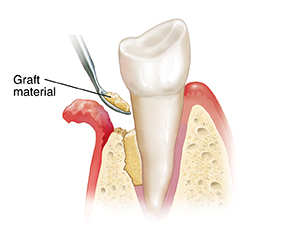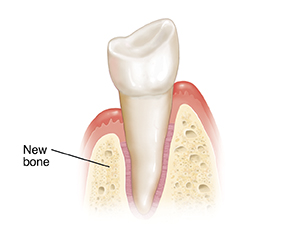Periodontal Disease: Bone Replacement Graft
Teeth are held in place by surrounding gums, bone, and other tissues. But periodontal disease can cause the bone to break down. Certain methods called regenerative procedures can be used to stimulate new bone growth. This growth increases the height of the bone around the tooth, giving the tooth more support. Getting back even half the lost bone height extends the life of the tooth. One type of regenerative procedure is called a bone replacement graft.
How a bone replacement graft works
A graft helps your body replace lost bone. The graft consists of your own bone, synthetic material, or bone from a tissue bank. A gel containing growth factors may also be used to stimulate tissues to grow. This is how a graft is done:
-
Placing the graft. First, a gum flap is created. Growth factors may then be applied to the root. Graft material is packed into the area where bone was lost. This material provides a platform for new bone to grow. In some cases, a membrane may be needed to cover the graft. It may dissolve on its own or may need to be removed after healing.
-
Closing up. The gum is closed and sewn together. The growth factors stimulate tissue to grow.
-
After the area heals. Stitches dissolve or are removed. Though the gum has healed, it takes a year or more for new bone growth to fill the space. Good oral hygiene and regular dental visits are needed to maintain the health of the gums.
 |
| Placing the graft. |
 |
| After the area heals. |
Online Medical Reviewer:
Daphne Pierce-Smith RN MSN
Online Medical Reviewer:
Rita Sather RN
Date Last Reviewed:
5/1/2025
© 2000-2025 The StayWell Company, LLC. All rights reserved. This information is not intended as a substitute for professional medical care. Always follow your healthcare professional's instructions.